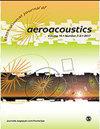利用上游汽缸上的沟槽结构减少汽缸-翼型相互作用产生的噪声
IF 1.3
4区 工程技术
Q3 ACOUSTICS
引用次数: 2
摘要
通过改变下游翼型前缘的形状,可以降低汽缸与翼型的相互作用噪声。一般来说,这种方式不仅可以降低中高频的相互作用噪声,而且可以改变低频的峰值噪声。本研究试图从减小上游尾流脱落涡强度的角度来影响汽缸-翼型相互作用噪声。为了实现这一目标,在上游圆柱上切割等间距的凹槽,并在不同来流速度(20 ~ 60m·s−1)下进行了声学风洞试验,比较了NACA0012模型的圆柱-翼型相互作用噪声。研究发现,沟槽结构能有效降低1000 Hz以下特征频率处的峰值噪声和1000 ~ 3000 Hz中频处的宽带噪声,特别是对于较高的入射速度。其中,在入射速度为60 m·s−1时,带槽圆柱的峰值噪声和总声压级(OASPL)分别降低了13 dB和7.2 dB。基于大涡模拟(LES)和Ffowcs williams - hawkins (FW-H)声学模拟的数值模拟进一步揭示了速度为60 m·s−1时的降噪机理。结果表明:沟槽结构抑制了翼型尾迹涡脱落,并将翼型前缘涡结构切割成小尺度涡结构。槽形圆柱尾迹的压力波动幅值和湍流动能峰值明显减小。此外,进一步的频谱分析表明,沟槽筒体上旋涡脱落的弱相关性可以抑制筒体尾迹中的压力波动,从而显著降低相互作用噪声。本文章由计算机程序翻译,如有差异,请以英文原文为准。
Reduction of noise generated by cylinder-airfoil interaction using grooved structures on the upstream cylinder
The cylinder-airfoil interaction noise can be reduced by changing the shape of the leading edge of the downstream airfoil. Generally, this way not only can reduce the interaction noise at middle and high frequency, but also can change the peak noise at the low frequency. This study attempts to affect the cylinder-airfoil interaction noise from the perspective of reducing the intensity of the upstream wake shedding vortex. In order to achieve this target, the equally spaced grooves were cut into the upstream cylinder, and the acoustic wind tunnel tests at various incoming velocities (20–60m·s−1) were conducted to compare the interaction noise of cylinder-airfoil (NACA0012) models. It is found that the grooved structure can effectively reduce the peak noise at characteristic frequencies bellow 1000 Hz and the broadband noise in the mid-frequency ranging from 1000 Hz to 3000 Hz, especially for the higher incoming velocity. Thereinto, the peak noise and overall sound pressure level (OASPL) with the grooved cylinder are reduced by 13 dB and 7.2 dB, respectively at the incoming velocity of 60 m·s−1. The numerical simulations based on the large eddy simulation (LES) and Ffowcs Williams–Hawkings (FW-H) acoustic analogy were performed to further reveal the mechanisms of noise reduction when the velocity is 60 m·s−1. The results show that the vortex shedding from cylinder wake is suppressed by the grooved cylinder and the vortex structure at the leading edge of the airfoil is also cut into the small-scale vortex structures by the grooved structure. The pressure fluctuation amplitude and the peak value turbulent kinetic energy in the wake of the grooved cylinder are significantly reduced. In addition, the further spectrum analysis reveals that the weak correlation of the vortex shedding on the grooved cylinder could lead to the suppression of the pressure fluctuation in the cylinder wake, and thereby the interaction noise is significantly reduced.
求助全文
通过发布文献求助,成功后即可免费获取论文全文。
去求助
来源期刊

International Journal of Aeroacoustics
ACOUSTICS-ENGINEERING, AEROSPACE
CiteScore
2.10
自引率
10.00%
发文量
38
审稿时长
>12 weeks
期刊介绍:
International Journal of Aeroacoustics is a peer-reviewed journal publishing developments in all areas of fundamental and applied aeroacoustics. Fundamental topics include advances in understanding aeroacoustics phenomena; applied topics include all aspects of civil and military aircraft, automobile and high speed train aeroacoustics, and the impact of acoustics on structures. As well as original contributions, state of the art reviews and surveys will be published.
Subtopics include, among others, jet mixing noise; screech tones; broadband shock associated noise and methods for suppression; the near-ground acoustic environment of Short Take-Off and Vertical Landing (STOVL) aircraft; weapons bay aeroacoustics, cavity acoustics, closed-loop feedback control of aeroacoustic phenomena; computational aeroacoustics including high fidelity numerical simulations, and analytical acoustics.
 求助内容:
求助内容: 应助结果提醒方式:
应助结果提醒方式:


